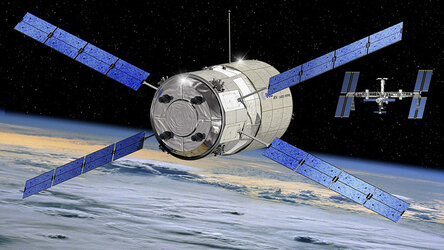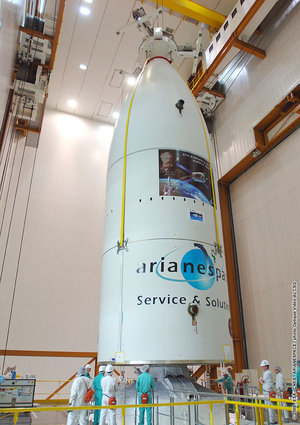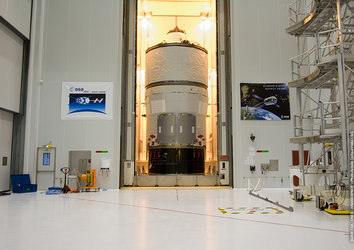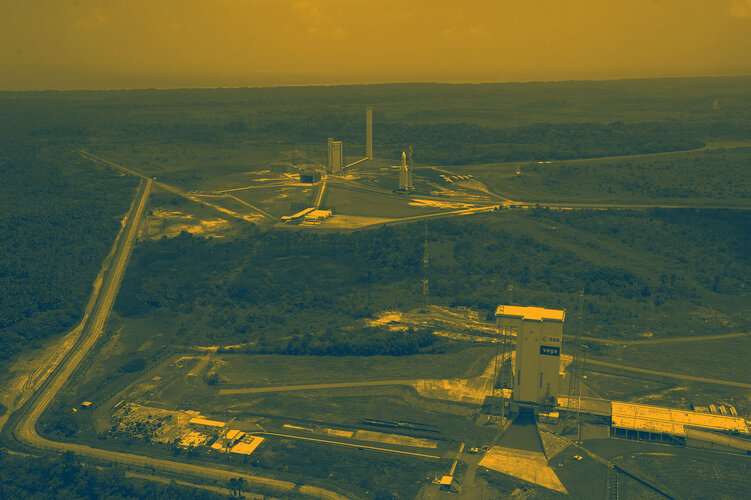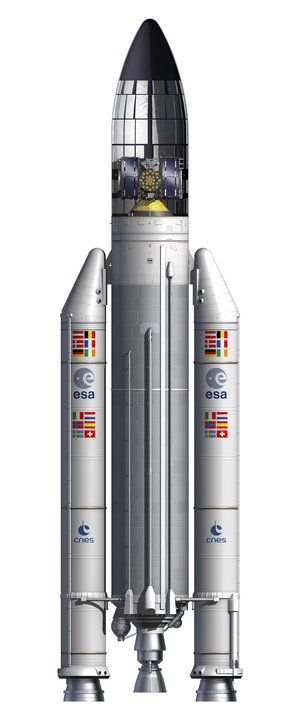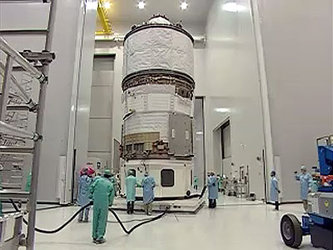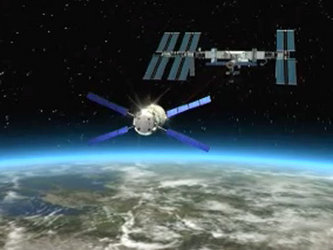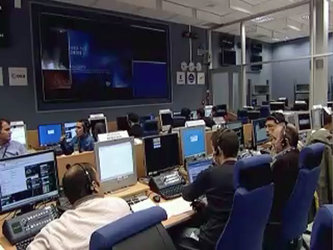A dedicated Ariane 5 to launch Jules Verne
Jules Verne, the first Automated Transfer Vehicle, will be launched this Sunday by a special version of Ariane 5 called the Ariane 5 Evolution Storable upper stage Automated Transfer Vehicle, or A5 ES-ATV for short.
Although the Automated Transfer Vehicle (ATV) does not use the powerful ECA version of Ariane 5, which was qualified successfully in 2005 for launches on geostationary transfer orbit, it does need an Ariane 5 equipped with the powerful Vulcain 2 main engine, and featuring the storable propellant upper stage (Etage à Propergols Stockables or EPS) and its re-ignitable engine, the Aestus.
Some adaptations to the launcher are also necessary to ensure compatibility with the heavy ATV spacecraft and its specific delivery orbit. For the recurring flights, the launcher will inject the more than 20 tonnes ATV into the International Space Station orbital plane in low Earth orbit at about 300 km altitude inclined 51.6 degrees above the Equator. For the first ATV mission, Jules Verne with a mass of 19 360 kg, the orbit is also slightly lower at 260 km.
New mission for Ariane 5

Since it is the first time the European heavy launcher will aim at such a low Earth orbit (LEO) trajectory and since it will launch its heaviest payload ever, the Ariane 5 ES-ATV has needed some hardware adaptation and some specific tests and studies.
The more than 20-tonne ATV mass represents more than twice the heaviest single payload Ariane 5 has ever lifted in the past, including Envisat, the 8-tonne environment satellite. “To handle such a heavy-weight, the Vehicle Equipment Bay, supporting the ATV on top of the launcher, has been structurally redesigned and strengthened accordingly,” explains Julio Monreal, now ESA's head of Ariane Qualification Verification Division and formerly in charge of the ATV-Ariane 5 interfaces.
The second main adaptation activity has been to analyze and review the piloting of the 775-tonne Ariane 5 during ascent and insertion, taking into consideration the aerodynamic, thermal and electromagnetic environments. With such a huge mass at the top of Ariane 5, the rocket's centre of gravity is quite different to any previous Ariane 5 launch.
“It will be a major milestone for Ariane 5 to lift such a record payload in low Earth orbit, and it will show a new capability of this multi-task launcher. The work to enlarge the Ariane 5 flight domain has been made possible thanks to the united efforts of teams from ESA, CNES, Arianespace and the Ariane industry”, underlines Jean-Michel Desobeau, Arianespace's ATV Programme Director.
Jules Verne ascent and insertion
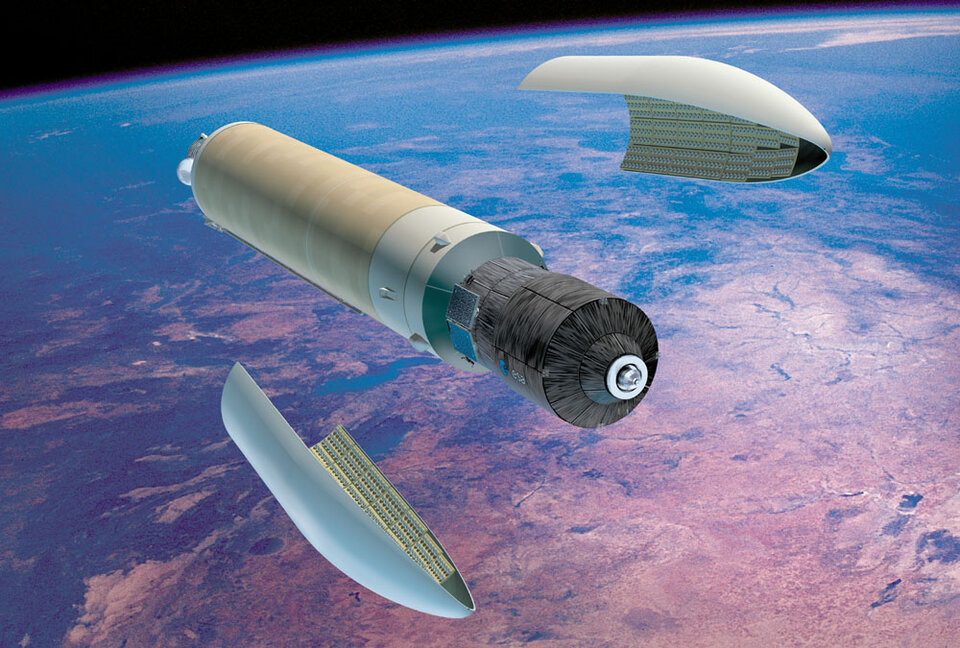
About two minutes and ten seconds after lift-off from Europe's Spaceport in French Guiana, the two solid rocket boosters separate from the main central stage, about one minute and ten seconds later, the Ariane 5 long version fairing protecting the ATV is ejected.
Five and a half minutes later, the main cryogenic stage (Etage à Propergol Cryogénique or EPC) separates, leaving the ATV attached to the upper stage. The upper stage carries the ATV to a circular orbit at an altitude of 260 km, using two powered phases with its Aestus motor, separated by a 45-minute ballistic phase:
- After EPC separation, the EPS upper stage motor, Aestus, is ignited for about eight minutes, over the Atlantic Ocean, before the ballistic trajectory, which describes half an orbit around the Earth.
- Whilst passing over southeast Australia, the Ariane 5 re-ignites, a first time, for about 30 seconds its EPS upper stage Aestus motor to circularize the orbit at an altitude of 260 km. Four minutes later, the ATV separates over the Pacific and becomes a fully automated spaceship, navigating towards the International Space Station.
- Meanwhile, the EPS and the equipment bay of the Ariane 5 fulfil a last and important task. One orbit later, now over western Australia, Aestus re-ignites briefly, for a second time, causing the launcher to de-orbit safely and burn up during a precise re-entry over a predefined uninhabited South Pacific area.

The adaptation of Ariane 5 has required four and a half years of work. This ESA programme has been implemented by the French space agency CNES through ASTRIUM Space Transportation, the prime contractor. From January 2008 on, the launcher has been integrated and checked for the Jules Verne mission. Now, Arianespace is preparing the launch itself in French Guiana according to the requirements of ESA in coordination with NASA and Russian counterparts.
“With the launch of Jules Verne and the follow-up ATV flights, the whole Ariane 5 transportation system is starting a new era related to human spaceflights; although no crew will be launched in an ATV, this vehicle complies with the human spaceflight safety requirements and, for the first time, the Ariane 5 launcher will fulfil a mission for ESA's Human Spaceflight, Microgravity and Exploration Directorate”, explains Arianespace's chief executive Jean-Yves Le Gall.
Ariane 5 ES-ATV
| Launch configuration | |
|---|---|
| Launch vehicle | Ariane 5 ES-ATV |
| Mass at launch | 775 tonnes |
| Orbit altitude | 260 km x 260 km |
| Orbit inclination | 51.6° |
| Long fairing height | 17 m |
| Main stage propulsion | Vulcain 2 |
| Upper stage | EPS (Etage à Propergols Stockables) storable propellants upper stage: re-ignitable |
| Upper stage propulsion | Re-ignitable Aestus |
| Solid strap-on boosters | 2 EAPs (Etages d’accelération à Poudre) |
| ATV dimensions | |
|---|---|
| ATV mass at launch (generic) | > 20 000 kg |
| Overall ATV length | 10.3 m |
| Larger ATV diameter | 4.51 m |
| ATV-A5 interface diameter | 3.936 m |



